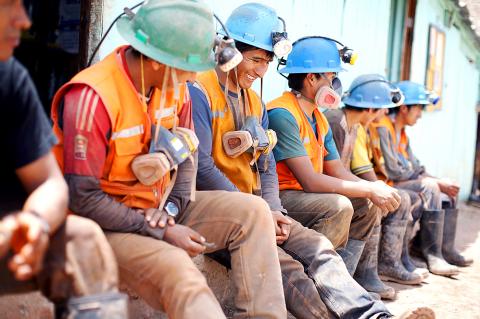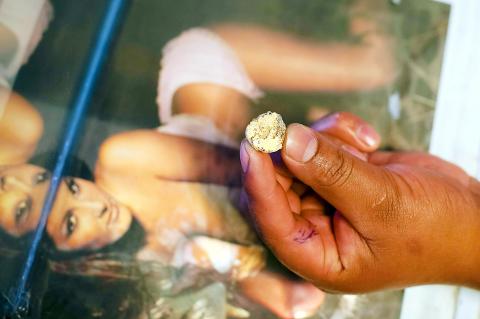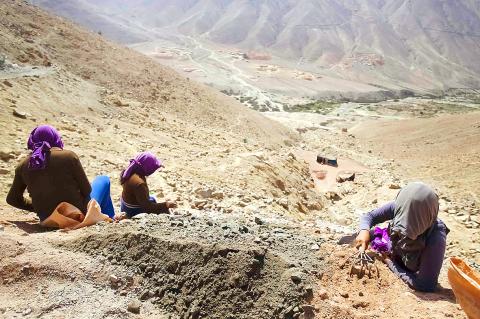Tucked between two desert ridges in southern Peru, Relave looks like any of the hundreds of ramshackle mining towns that blight the landscape in the world’s sixth-largest gold exporter.
Its name in Spanish means “tailings,” a nod to the heaps of mining waste that the town, a sprawling collection of wooden shacks and simple concrete huts, sits upon.
However, Relave is also home to Aurelsa, one of the first small-scale mines in the world to produce gold certified and marketed as “ethical,” as part of a scheme aimed at reducing the harmful impact of illegal mining in mineral-rich developing countries.

Photo: Reuters
“When we arrived we didn’t have anything... Now we’re exporting internationally,” said Juan Coronado, the chief executive at Aurelsa who came to Relave in the late 1980s to sift through what was left of an abandoned gold mine after leaving his family farm in the Andean highlands.
He used to collect the abandoned mine’s tailings, mix them with mercury, and sell the amalgam to middlemen in a nearby town.
Then he joined forces with a small group of illegal miners to set up Aurelsa as a legal company in 2000, paying taxes and abiding by industry regulations.

Photo: Reuters
It struggled at first to compete with illegal operations that had virtually no overhead, but in 2011 it opened talks with the Alliance for Responsible Mining (ARM), an advocacy group that seeks to improve small-scale miners’ working conditions through direct sales to overseas customers.
Aurelsa, with 45 employees, made its first direct international sale in June last year, 1kg of gold certified as “ethical” by ARM. It has since exported another 10kg of ethical gold.
While Aurelsa still sells some gold to middlemen, it hopes that all of its production — currently at 2kg to 3kg per month — will soon be marketed and sold as ethical gold.

Photo: Reuters
There are three other mines like Aurelsa in South America and last year they exported a combined 360kg of ethical gold to boutique jewelers in the US and in Europe.
Miners at Aurelsa work in well-lit tunnels and take home regular paychecks, a vast improvement over other mines in Relave, a town of about 4,000 people.
Across from Aurelsa’s active mineshaft, hundreds of illegal miners dig without protective gear at La Capitana, an imposing hunk of rock that locals say has been mined for more than two centuries.
“In any one of those, you’d have to crawl to get inside, and you wouldn’t be able to see anything,” Aurelsa engineer Daniel Arcos said.
As the price of gold soared to record highs over the past decade, hundreds of thousands of poor people from Peru to Indonesia have scoured rivers and mountains for the ore at makeshift mines that operate outside of the law.
Working without environmental and legal permits, they typically use large amounts of mercury to separate the precious metal from rock, often handling the neurotoxin with their bare hands and inhaling its fumes when it is burned off.
Miners sell their nuggets to middlemen and processing plants that refine the metal before shipping it abroad to refineries, where ore collected from all over the world becomes bullion.
Refineries source most of their gold from large mining firms that operate globally, though industry experts say there is no way to tell for sure where the ore originally came from by the time the bullion is sold to dealers and consumers.
The ethical gold initiative aims to change that by selling directly to wholesale consumers at a 10 percent premium in exchange for assurances that they are rewarding fair labor practices and a commitment to environmental protection.
“I was so frustrated with the industry before,” said Amanda Li Hope, a London-based jeweler who was one of the first to buy ethical gold. “No bullion dealer could 100 percent guarantee where anything was coming from.”
Li Hope markets her guilt-free gold rings, necklaces and earrings online, and has bought about 130g of gold labeled “fairmined” or “fairtrade” since 2011.
Peru’s government estimates that more than 100,000 illegal miners are now working in the country of 30 million, though others say the true number of wildcatters is closer to 500,000.
High gold prices have especially lured poor Peruvians to the Amazon, where more than 50,000 hectares of rainforest have been destroyed to make way for makeshift alluvial mines, according to researchers at the Carnegie Department of Global Ecology. The boom has resulted in more than 2,700 tonnes of mercury leaked or dumped into the country’s rivers, according to the government.
In one area rife with wildcatting, nearly 80 percent of the population has dangerous levels of mercury in their bodies, researchers from the Carnegie Institution for Science found.
The gold rush is also tied to a host of social ills, from prostitution in boomtown brothels to child labor in the pits.
Peru’s gold output was 137 tonnes last year, but government statistics show that it exports roughly 20 percent more than it produces. Economist Elmer Cuba says it is a sign that illicit gold — the kind often linked to organized crime and deforestation — is regularly laundered into the export market.
While Peru tries to crack down on illegal mining, advocates of ethical gold say lasting solutions lie not in police operations, but in business savvy and financial incentives.
ARM and another group, Fairtrade International, put their “fairmined” and “fairtrade” stamps of approval on gold in exchange for commitments by the small mining firms to adhere to environmental, social and labor standards.
Both use similar compliance guidelines and perform surprise inspections on miners whose products they endorse. They say they do not trade in gold or take a cut of exports.
The initiative builds on similar efforts to get big mining companies to source ore under tougher standards and to prevent the international trade in “blood diamonds” from conflict zones.
Aurelsa mine manager Maria Rosa Reyes said word is spreading that formalizing a mining operation as required by law can bring big benefits.
“Without being organized as a formal company, there is no legal way to buy inputs like dynamite and cyanide, there’s no way to get financing,” she said. “And without those things you can’t produce” at an export scale.
Aurelsa’s first batch of certified gold sold directly to an overseas buyer went to Ethical Metalsmiths, a US boutique jewelry consortium.
Ethical Metalsmiths executive director Christina Miller said the transaction took much longer than she expected — a potential obstacle for ethical gold producers new to exporting — but that she is still planning future purchases.
Aurelsa and the other certified mines in South America will probably produce more than a tonne of gold by 2015, ARM business liaison Kenneth Porter said.
That is a drop in the ocean of global supply, but would represent more than US$44 million in sales at today’s prices.
Advocates say that as the supply of ethical gold increases, more buyers will learn it exists and ask for it.
ARM executive director Lina Villa-Cordoba said the next step is to get a big jewelry firm to commit to buying ethical gold. Ultimately she hopes to reach the banks and traders that buy gold as a financial instrument.
“We have to find a way to create industry-wide demand, to move the market,” Villa-Cordoba said.

To many, Tatu City on the outskirts of Nairobi looks like a success. The first city entirely built by a private company to be operational in east Africa, with about 25,000 people living and working there, it accounts for about two-thirds of all foreign investment in Kenya. Its low-tax status has attracted more than 100 businesses including Heineken, coffee brand Dormans, and the biggest call-center and cold-chain transport firms in the region. However, to some local politicians, Tatu City has looked more like a target for extortion. A parade of governors have demanded land worth millions of dollars in exchange

An Indonesian animated movie is smashing regional box office records and could be set for wider success as it prepares to open beyond the Southeast Asian archipelago’s silver screens. Jumbo — a film based on the adventures of main character, Don, a large orphaned Indonesian boy facing bullying at school — last month became the highest-grossing Southeast Asian animated film, raking in more than US$8 million. Released at the end of March to coincide with the Eid holidays after the Islamic fasting month of Ramadan, the movie has hit 8 million ticket sales, the third-highest in Indonesian cinema history, Film

Taiwan Semiconductor Manufacturing Co’s (TSMC, 台積電) revenue jumped 48 percent last month, underscoring how electronics firms scrambled to acquire essential components before global tariffs took effect. The main chipmaker for Apple Inc and Nvidia Corp reported monthly sales of NT$349.6 billion (US$11.6 billion). That compares with the average analysts’ estimate for a 38 percent rise in second-quarter revenue. US President Donald Trump’s trade war is prompting economists to retool GDP forecasts worldwide, casting doubt over the outlook for everything from iPhone demand to computing and datacenter construction. However, TSMC — a barometer for global tech spending given its central role in the

Alchip Technologies Ltd (世芯), an application-specific integrated circuit (ASIC) designer specializing in server chips, expects revenue to decline this year due to sagging demand for 5-nanometer artificial intelligence (AI) chips from a North America-based major customer, a company executive said yesterday. That would be the first contraction in revenue for Alchip as it has been enjoying strong revenue growth over the past few years, benefiting from cloud-service providers’ moves to reduce dependence on Nvidia Corp’s expensive AI chips by building their own AI accelerator by outsourcing chip design. The 5-nanometer chip was supposed to be a new growth engine as the lifecycle